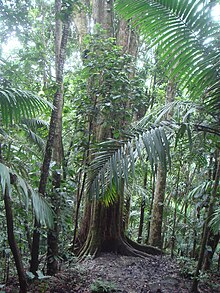bio.wikisort.org - Plant
Manilkara bidentata is a species of Manilkara native to a large area of northern South America, Central America and the Caribbean. Common names include bulletwood,[5] balatá, ausubo, massaranduba, quinilla, and (ambiguously) "cow-tree".
| Manilkara bidentata | |
|---|---|
 | |
| Scientific classification | |
| Kingdom: | Plantae |
| Clade: | Tracheophytes |
| Clade: | Angiosperms |
| Clade: | Eudicots |
| Clade: | Asterids |
| Order: | Ericales |
| Family: | Sapotaceae |
| Genus: | Manilkara |
| Species: | M. bidentata |
| Binomial name | |
| Manilkara bidentata | |
| Synonyms | |
|
Mimusops bidentata A.DC. | |
Description
The balatá is a large tree, growing to 30–45 m (98–148 ft) tall. The leaves are alternate, elliptical, entire, and 10–20 cm (3.9–7.9 in) long. The flowers are white, and are produced at the beginning of the rainy season. The fruit is a yellow berry, 3–5 cm (1.2–2.0 in) in diameter, which is edible; it contains one (occasionally two) seed(s). Its latex is used industrially for products such as chicle.
Uses
The latex is extracted in the same manner in which sap is extracted from the rubber tree. It is then dried to form an inelastic rubber-like material. It is almost identical to gutta-percha (produced from a closely related southeast Asian tree), and is sometimes called gutta-balatá.
Balatá was often used in the production of high-quality golf balls, to use as the outer layer of the ball. Balatá-covered balls have a high spin rate, but do not travel as far as most balls with a Surlyn[6] cover. Due to the nondurable nature of the material the golf club strikes, balatá-covered balls do not last long before needing to be replaced. While once favored by professional and low-handicap players, they are now obsolete, replaced by newer Surlyn and urethane technology.
Today, Brazil is the largest producer of Massaranduba wood, where it is cut in the Amazon rainforest.
The tree is a hardwood with a red heart, which is used for furniture and as a construction material where it grows. Locals often refer to it as bulletwood for its extremely hard wood, which is so dense that it does not float in water. Drilling is necessary to drive nailed connections. In trade, it is occasionally (and incorrectly) called "brazilwood".
The fruit, like that of the related sapodilla (M. zapota), is edible.
Though its heartwood may present in a shade of purple, Manilkara bidentata should not be confused with another tropical tree widely known as "purpleheart", Peltogyne pubescens.[7]
This timber is being used to produce outdoor furniture and is being marketed as "Pacific Jarrah" in Australia.
- Manilkara bidentata - MHNT
- Harvesting bulletwood in Guyana
- A whip handle of balatá, made before 1939
References
- Rev. Bot. Appliq. 1932, xii. 270. "Plant Name Details for Manilkara bidentata". IPNI. Retrieved December 25, 2009.
Notes: Mimusops bidentata
- Prodr. (DC.) 8: 204. 1844 [mid Mar 1844] "Plant Name Details for Mimusops bidentata". IPNI. Retrieved December 25, 2009.
Notes: =globosa
- Suppl. Carp. 132 (t. 205). 1807 "Plant Name Details for Mimusops globosa". IPNI. Retrieved December 25, 2005.
- "Mimusops balata Crueg. ex Griseb". The Plant List. Royal Botanic Gardens, Kew and Missouri Botanical Garden. Retrieved August 4, 2011.
- USDA, NRCS (n.d.). "Manilkara bidentata". The PLANTS Database (plants.usda.gov). Greensboro, North Carolina: National Plant Data Team. Retrieved 29 June 2015.
- "Ionomer Resin- DuPont™ Surlyn® - DuPont USA". 2.dupont.com. Retrieved 19 November 2017.
- "Lumber". Archived from the original on 2009-01-06. Retrieved 2009-05-19.
External links
 Media related to Manilkara bidentata at Wikimedia Commons
Media related to Manilkara bidentata at Wikimedia Commons Data related to Manilkara bidentata at Wikispecies
Data related to Manilkara bidentata at Wikispecies
На других языках
[de] Balatabaum
Der Balatabaum (Manilkara bidentata) ist eine Pflanzenart aus der Familie der Sapotengewächse (Sapotaceae). Er ist weit verbreitet auf den Karibischen Inseln und im tropischen Mittel- und nördlichen Südamerika.[1]- [en] Manilkara bidentata
Другой контент может иметь иную лицензию. Перед использованием материалов сайта WikiSort.org внимательно изучите правила лицензирования конкретных элементов наполнения сайта.
WikiSort.org - проект по пересортировке и дополнению контента Википедии


